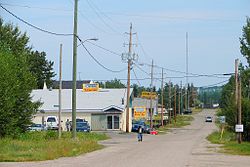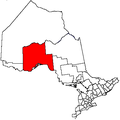Armstrong | |
|---|---|
compact rural community unincorporated place | |
 | |
| Coordinates: 50°18′18″N89°02′31″W / 50.30500°N 89.04194°W [1] | |
| Country | Canada |
| Province | Ontario |
| District | Thunder Bay |
| Time zone | UTC-5 (Eastern Time Zone) |
| • Summer (DST) | UTC-4 (Eastern Time Zone) |
| Postal Code | P0T 1A0 |
| Area code | 807 |
Armstrong is a compact rural community, unincorporated place, and divisional point on the Canadian National Railway transcontinental railway main line in the unorganized portion of Thunder Bay District in Northwestern Ontario, Canada. [1] The Whitesand First Nation's Armstrong Settlement is coterminous to this community. The Armstrong area is a popular tourist destination in the summer for fishing and hunting.
Contents
The community is not part of an incorporated municipality, but is administered by a local services board. [2]
Canadian Forces Station Armstrong, located 1.1 miles (1.8 km) east of Armstrong, was closed in 1974. Later that year the base was sold to private owners and turned into a popular gathering area for the town that included a restaurant and bar, hotel, multiple apartments, garages, and a curling rink. The area, known as D&L, was closed and abandoned in 1993 and remains that way today.
The town of Armstrong currently has a public school, two restaurants, a Canada Post post office, a clinic, a Mini Mart gas station and motel, and the Armstrong General Store (formerly the J&J General Store, from 1961 to 2015).


